1960s
The editor who featured herself
The undergrads at Tampa University had major complaints about their 1967 yearbook. For a start, all their yearbook photos were destroyed in a warehouse fire. So they didn't appear in it at all. And then, the yearbook they got was dominated by pictures of one person, the yearbook editor Carmen Gonzalez. Her picture appeared 24 times in it, including a six-page spread devoted to her as yearbook queen.When people complained, Gonzalez explained, "I got into every section because I was in everything." She elaborated that she was not only yearbook queen, but also belonged to at least 10 clubs, was named a member of Who's Who, and had the highest scholastic average at the university. Therefore, it was only natural that she gave most coverage to herself.
The students responded by holding a rally at which they burned 500 of the 2000 yearbooks that had been printed.
Sounds to me like Gonzalez was a woman ahead of her time. She would have thrived in the age of social media.

Racine Journal Times - May 27, 1967

The Tampa Tribune - May 27, 1967
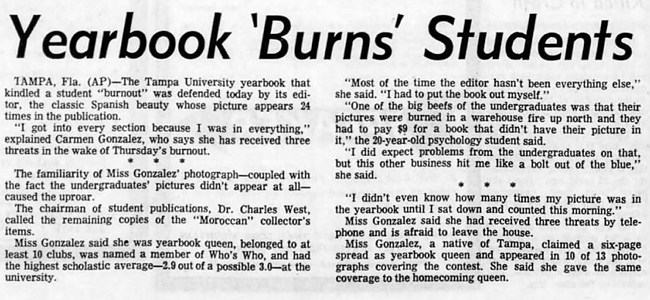
Battle Creek Enquirer - May 27, 1967
Posted By: Alex - Wed Feb 07, 2018 -
Comments (4)
Category: 1960s, Universities, Colleges, Private Schools and Academia
Salad Beauty Treatment
Posted By: Paul - Tue Feb 06, 2018 -
Comments (1)
Category: Beauty, Ugliness and Other Aesthetic Issues, 1960s, Europe
Robert F. Kennedy Bubble Gum Cards
After the assassination of Robert F. Kennedy in June, 1968, the Philadelphia Chewing Gum Corp. rushed out with a commemmorative, 55-card set of RFK bubble gum cards. It presented "the story of Robert F. Kennedy... with bubble gum."Kids must have been rushing out to get these.
The cards seem to have appreciated reasonably well in price. Individual cards now range from $3 to $26 in price. You can get an unopened pack for about $65.

image source: Huggins and Scott


Bridgeport Post - Aug 28, 1968
Posted By: Alex - Mon Feb 05, 2018 -
Comments (2)
Category: Collectors, 1960s
The mustard theory of heart disease
Given that just about everything one can possibly eat seems to be bad for you, I'm not sure if Dr. Jackson Blair was a crackpot or ahead of his time with his theory that mustard is the secret cause of heart disease.But for Blair, mustard was just the tip of the iceberg. It was "part of a wider theory that condiments—pepper, ginger, mustard and mayonnaise, which contains mustard—cause hypertension."
As with everything, I suspect how much of it one eats might play a role.
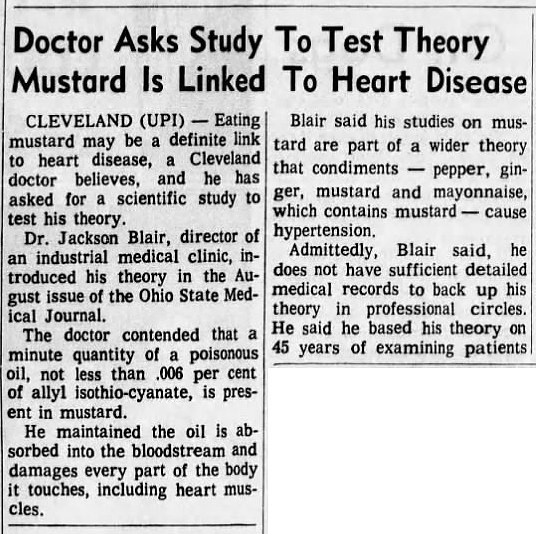
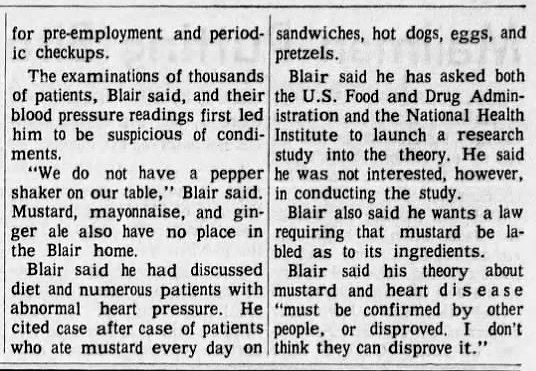
Palladium-Item and Sun-Telegram - Sep 2, 1965
Posted By: Alex - Sun Feb 04, 2018 -
Comments (0)
Category: Food, 1960s, Disease
Follies of the Madmen #350
"Telltale beverages" = booze.
Posted By: Paul - Sat Feb 03, 2018 -
Comments (3)
Category: Business, Advertising, Products, Hygiene, 1960s
Elva Miller
Elva Miller was the Florence Foster Jenkins of the 1960s. From her bio on Wikipedia:But she laughed all the way to the bank. Her rendition of "Downtown" sold 250,000 copies in three weeks, and reached No. 82 on the Billboard Hot 100 singles chart in April 1966.
If you're up for more sonic abuse, you can find plenty of her recordings on youtube.
Posted By: Alex - Thu Feb 01, 2018 -
Comments (6)
Category: Ineptness, Crudity, Talentlessness, Kitsch, and Bad Art, Music, 1960s
Chet Huntley Explains the Strategic Air Command
Be sure to enjoy the SAC theme song starting around 6:30.
Posted By: Paul - Thu Feb 01, 2018 -
Comments (7)
Category: Government, Music, War, Weapons, 1960s
Follies of the Madmen #349
FRANK ZAPPA'S LUDEN'S COUGH DROPS COMMERCIAL from ED SEEMAN on Vimeo.
Posted By: Paul - Wed Jan 31, 2018 -
Comments (3)
Category: Business, Advertising, Products, Music, Patent Medicines, Nostrums and Snake Oil, 1960s
Operation Decoy
In August 1962, New York City cops began patrolling the streets at night while dressed as women. The idea was to trap would-be muggers.But not all the decoy cops were successful at apprehending the muggers. Patrolman Victor Ortiz got hit over the head by a mugger, lost his gun, and his assailant got away.
Update: Author Erika Janik discusses Operation Decoy in her book Pistols and Petticoats: 175 Years of Lady Detectives in Fact and Fiction. She places it within the context of an ongoing resistance within the police department during the mid-twentieth century to the idea of having female police officers:
Some even went so far as to suggest that male officers could simply dress as women for undercover work. In 1962, eight male officers did just that in order to trap muggers and rapists in New York City. "We want our men to look like housewives, not like Hollywood stars," explained Inspector Michael Codd, head of the tctical force. Twenty-seven-year-old patrolman Victor Ortiz wore white sandals, orange tapered pants, and a beige padded sweater on top of a bright print blouse. On hand to help the officers get ready were two policewomen, Caryl Collins and Dolores Munroe. The women stood by in their official uniforms as the men posed for the TV and newspaper cameras. Why teaching men to wear heels and put on lipstick was deemed more useful than simply deploying policewomen seems a question the reporters never asked. It's true that decoys did get attacked as part of these operations (that was the point), but all officers worked in teams with detectives standing by to apprehend suspects. In this instance, two of the disguised policemen had their purses snatched in Central Park and seven people were arrested in the overnight anti-mugging operation.

Orlando Evening Star - Aug 25, 1962

Greenville News - Aug 24, 1962
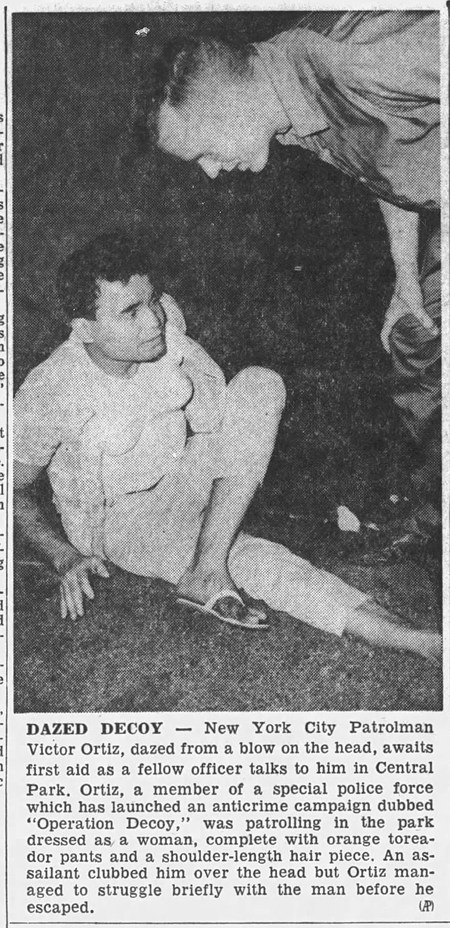
Allentown Morning Call - Aug 28, 1962

Posted By: Alex - Tue Jan 30, 2018 -
Comments (2)
Category: Police and Other Law Enforcement, Gender, 1960s
Swallowed the evidence
In November 1965, Walter Cunningham was arrested on suspicion of being involved in a jewel robbery. The police picked him up two days after the robbery, loitering outside a pawn shop. He didn't have the jewels on him, but when he later complained of a stomach ache, the police realized he had swallowed all the evidence: about 91 diamonds, a 20-karat ruby, and an emerald chip.Police Lt. Carl Schumacher told reporters, "We figure he must have swallowed the gems while he was being booked. He was probably standing there chomping away while our backs were turned."
Doctors subsequently recovered the jewels. Cunningham pleaded guilty to a federal charge of interstate transportation of stolen property.
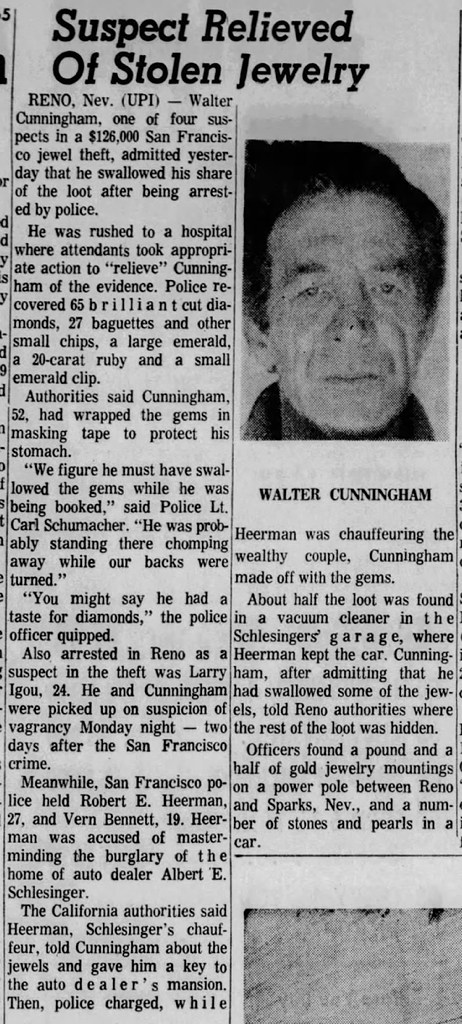
Santa Rosa Press Democrat - Nov 19, 1965
Posted By: Alex - Mon Jan 29, 2018 -
Comments (2)
Category: Crime, 1960s

| Who We Are |
|---|
| Alex Boese Alex is the creator and curator of the Museum of Hoaxes. He's also the author of various weird, non-fiction, science-themed books such as Elephants on Acid and Psychedelic Apes. Paul Di Filippo Paul has been paid to put weird ideas into fictional form for over thirty years, in his career as a noted science fiction writer. He has recently begun blogging on many curious topics with three fellow writers at The Inferior 4+1. Contact Us |




